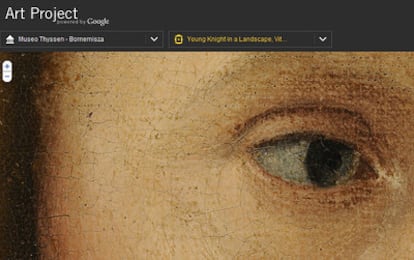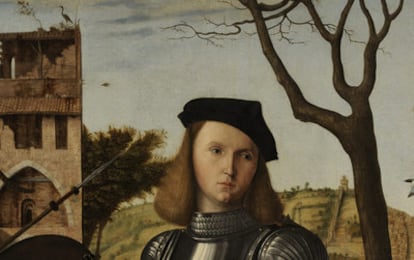Google plays to the galleries
Reina Sofía and Thyssen feature in search engine's new virtual art tour project
A global initiative with Spanish roots, Google's Art Project is set to change the way we approach art. The free website (www.googleartproject.com), which was presented in London this week, has two aims: to allow us to view works at a level of detail impossible with the naked eye and to allow us to stroll through the galleries of 17 museums around the world (Spain's Reina Sofía and Thyssen-Bornemisza among them) without the joy (or the annoyance) of sharing the shadows, glances and rushing of other visitors.
Knowing such details as the kind of sailboat the Italian artist Vittore Carpaccio suggests atop the watery point of refuge featured in Young Knight in a Landscape (1510) is only possible with an image of 14 billion pixels, a thousand times the detail you get with a normal camera. "I just went in and the resolution is incredible, it's almost a restorer's-eye-view," says Manuel Borja-Villel, director of the Reina Sofía Museum, which has submitted the work The Bottle of Anís del Mono by Juan Gris to Google's eye.
"We would love the Prado to come on board and the door is open"
The project includes 17 museums, 1,061 artworks and 486 artists
To attain such a high level of definition Google used professional cameras and a tool from Spanish company Madpixel that lets you capture high resolution images from sections of a canvas. Each painting has been photographed to the millimeter in a synchronized way. Millions of individual images were taken during the process, which were then brought together to rebuild the painting using the virtual photo album technology of Google's Picasa software.
The idea came from Madrid-born Clara Rivera, who was working for Google España when it occurred to her to focus on the search engine's popular art applications. She was behind the 2009 presentation of a plan for an application allowing people to see various works of art in high resolution from the Prado Museum, a gallery ultimately absent from the final project. "We would love for them to come onboard and the door is open," she says. Prado management sources this week explained that they did not think this project related to their work in exhibiting and presenting its collections. "That does not imply that we are closed to collaborating with Google again in the future on this or other projects that we consider of interest," said the same sources.
The figures for Google's Art Project, which is still in its initial phase, talk of 17 museums, 11 cities in nine countries, 17 gigapixelled paintings, more than 6,000 panoramas of gallery corridors, 1,061 images of works of art in high resolution, 486 artists and 385 rooms.
But what was presented in London is something more than high-resolution images. It is a luxury showcase for Google, which has put its best-known tools into a cocktail shaker and devoted them to art for a year and a half, an aim not intended at the beginning. Google Earth, its application for flying around the globe, now allows you to zoom in on just a few millimeters of a canvas. Street View, its service for walking virtually around city streets, now lets you go inside the corridors of galleries such as the Uffizi in Florence, New York's MoMA and the Hermitage in St Petersburg. What's more you can obtain other information about the works with applications such as Google Scholar, Google Docs and YouTube.
Visitors can also become curators of their personal selection of works, comment on them and share their virtual visits with friends.
Will this experience make museum visits redundant? The Reina Sofía's Borja-Villel doesn't think so. "It's just the opposite. All artworks have something physical, even the most conceptual art. The experience of touring a museum is irreplaceable."
And Clara Rivera agrees: "What this project does is invite people to journey to see the paintings, but we don't all have the opportunity to travel to New York or Moscow. Now we can access works of art from home."


A virtual museum visit
Lots of people are bound to say it's a million times better than real visit. And they are bound to be right. But things are changing so fast that the virtual visit offered by Google Art Project doesn't seem so crazy. Because it's not the virtual visit to which these same museums have gotten us used to. Here the idea is to organize an à la carte visit, properly touring the rooms, properly selecting the area or the work you want to see - which you can observe in minute detail via a zoom.
So perhaps, this is neither better nor worse than a physical walk around these art institutions: it is something else, which is reasonably entertaining, like a good part of what the internet presents, and with the usual links to the social networks you can share your favorite works. Why go to a museum in an age in which we send our would-be private lives to 3,000 close friends with whom we now never speak by cellphone?
Whatever the case, it's interesting that this kind of approach is thriving just at a time when contemplation, which has always ruled great art, has been replaced by analysis, as the works of the last 30 years prove. And not just that. It occurs at a moment favorable to tourism, with packed museums, guided visits; at a moment that has lost the old values of a museum where it was possible to run into the beautiful mourning Baudelaire. In a time of vulgarity and excess such as this, I feel more relaxed strolling around on my computer screen, remembering those rooms that I visited some time ago, and without the obscene numbers of tourists teeming around the Mona Lisa.
By the way, one thing that intrigues me about the network: why are the most important institutions, such as the Louvre, the Prado and the Pompidou, missing? The question has aroused my suspicions... Now at last we will see where this virtual tour around empty galleries ends.
Tu suscripción se está usando en otro dispositivo
¿Quieres añadir otro usuario a tu suscripción?
Si continúas leyendo en este dispositivo, no se podrá leer en el otro.
FlechaTu suscripción se está usando en otro dispositivo y solo puedes acceder a EL PAÍS desde un dispositivo a la vez.
Si quieres compartir tu cuenta, cambia tu suscripción a la modalidad Premium, así podrás añadir otro usuario. Cada uno accederá con su propia cuenta de email, lo que os permitirá personalizar vuestra experiencia en EL PAÍS.
¿Tienes una suscripción de empresa? Accede aquí para contratar más cuentas.
En el caso de no saber quién está usando tu cuenta, te recomendamos cambiar tu contraseña aquí.
Si decides continuar compartiendo tu cuenta, este mensaje se mostrará en tu dispositivo y en el de la otra persona que está usando tu cuenta de forma indefinida, afectando a tu experiencia de lectura. Puedes consultar aquí los términos y condiciones de la suscripción digital.
Últimas noticias
From Andorra to Gibraltar, a black market for Ozempic exploits its success: ‘They’re the most sought-after products in the world’
Magnets in their heads: How some animals guide themselves using the Earth’s magnetic field
From Hungary’s Orbán to Chile’s Kast: How Trump helps turbo charge the far right
The brief rise and retreat of Generation Z in Mexico
Most viewed
- Why we lost the habit of sleeping in two segments and how that changed our sense of time
- Trump’s obsession with putting his name on everything is unprecedented in the United States
- Charles Dubouloz, mountaineering star, retires at 36 with a farewell tour inspired by Walter Bonatti
- Venezuela faces its most tense Christmas yet
- The Florida Keys tourist paradise is besieged by immigration agents: ‘We’ve never seen anything like this’








































